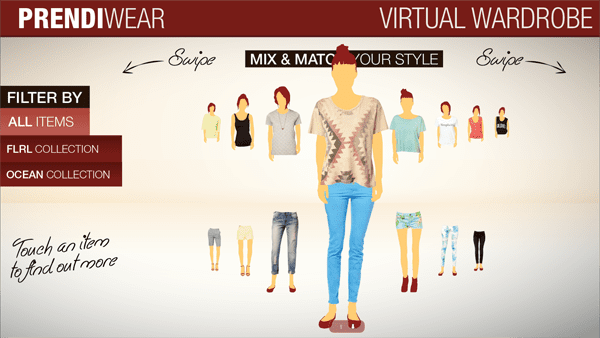Virtual signage integrator, Prendi, has responded to the ever-challenging consumer landscape with their new product – Virtual Wardrobe – helping retailers bring some of that online shopping experience into their store.
Consumer shopping habits having shifted drastically with the advent of online shopping. Australians are increasingly shopping online, and as a result, retailers are having to work harder at gaining and retaining customers.
In response to this shift, as well as growing concerns among retailers about becoming irrelevant in the face of technological change, Prendi decided to create the Virtual Wardrobe – a digital touch-screen device that aims to help retailers combine technology and an in-store experience in a way that is engaging for customers.
Tanya Williams, Prendi’s Business Development Manager, explained that the technology can be put in, for example, a visual merchandising area of a shopping centre and feature a number of clothing options from all the retailers within the centre.
Consumers can then mix and match outfits they might be interested in buying and retrieve information about the brand, price, sizing, and material for further consideration.
“It combines the best of both worlds – online and in-store shopping. It not only gets customers into a retail store, it gets them excited about the brand because they are offering them something different … Most importantly though, it’s about engaging people in that retail environment when they’re there,” said Williams, who also confessed to being a shopaholic.
She went on to explain that retailers are often complaining about the lack of customers they’re getting, and are becoming victim to an evolving market.
“It’s time for retailers to stop complaining and start actioning. I am the perfect target customer for a fashion retailer. I have disposable income and I’m not afraid to spend it, [but] you have to give me a reason to,” said Williams.
The 2013 Mobile Life study showed that Australian consumers are interested in a ‘virtual sales assistant’ who will help answer their questions in-store about a particular product – as opposed to waiting in store to be served by a salesperson.
Many shoppers prefer ‘a silent salesperson’ who can provide them with the information they need quickly and easily.
“Consumers love touch-screen devices where they can have information readily available at their fingertips. Consumers want to drive their own in-store experience, they want to interact with products in a new way,” said Williams.
One thing that frustrates consumers is the trial process, noticed Williams. Consumers still want to be able to experiment with outfits, but without having to exhaust so many possibilities in the change rooms.
“With the Virtual Wardrobe you can still visualise how the outfit will look, but without the effort of having to try them all on,” said Williams.
She also explained that retailers today are failing at providing a positive customer experience, meaning that customers have no reason to return to the store for future purchases.
“Shopping is about the entire experience whether it is online or in-store. More often than not, traditional retailers are failing to offer a positive experience in-store,” said Williams.
According to Williams, the benefits of using The Virtual Wardrobe or bringing other digital technologies into the retail environment include:
- More up-sell and cross-sell opportunities.
A lot of the time consumers don’t notice all the products that are available in store. A product like the Virtual Wardrobe may draw their attention to a product they would have otherwise missed.
- Create opportunities to gain back customers.
Many fashion brands are reinventing themselves – e.g. Sussan and Target. If they feature some of their new items on a digital platform like the Virtual Wardrobe, it would draw the attention of consumers who wouldn’t otherwise visit the store.
- Make shopping more convenient for those with a busy lifestyle.
Some consumers are too busy to go through the whole process of looking through clothes in store, waiting to be served and trying them on. If they can use a digital tool that brings them information instantly, they can save that information for later purchase.

